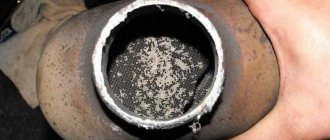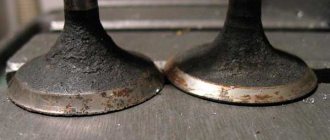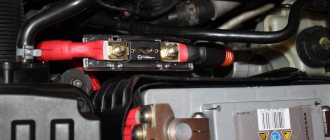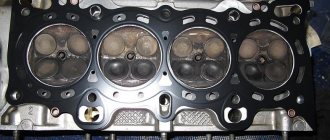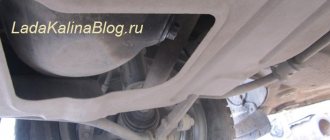Content
- Why the origin of Galant VIII is important
- Richness of motor range
- Gearboxes for Mitsubishi Galant VIII
- Sores of the old "Galants"
- With what problems is it sold?
- To take it or not
This review was prepared at the request of one of the readers of the avtocod.ru blog. In this article we talk about a hit item from the turn of the nineties and two thousand, which still holds up with dignity today - Mitsubishi Galant VIII.
It appeared in the Russian vehicle fleet when the institution of official dealership had not yet developed, the dollar was cheap, and customs rules were loyal. Therefore, cars came to our country second-hand and mainly from three sides: Europe, the USA and Japan. Some of them came from the Middle East, but Arab cars are traditionally technically closer to American ones, so it’s logical to take them there.
Review of the Mitsubishi Galant car (Mitsubishi Galant)
It will take you no more than 6 minutes to read this post.
Brief overview of the Mitsubishi Galant VIII Restyling:
- Production date: 2002 (in Russia since 2007)
- Manufacturer: Mitsubishi Motors
- Country of origin: America (USA)
- Model - Galant (EA3A)
- Modification - 2.4L (4G64)
- Engine - injector, gasoline
- Power - 150 hp
- Transmission - 5-speed automatic transmission (automatic)
- Engine capacity - 2350 cc.
- Body color: burgundy metallic, pearlescent
- Interior - gray, velor
Equipment:
- Exchange rate stabilization system
- Anti-lock braking system (ABS, not found on all models)
- Air conditioning (less common, but climate control is also common)
- Cruise control (installed on most models)
- 2 front airbags
- Adjusting the driver and passenger seats horizontally
- Adjusting the steering wheel vertically
- Power steering
- central locking
- Power windows and mirrors
About the eighth generation Mitsubishi Galant
Designer: Akinori Nakanishi General information:
- Manufacturer: Japan, America, Europe
- Years of production: 1996-2006
- Other designations: Mitsubishi Legnum, Mitsubishi Aspire
- Body types: sedan, station wagon
Characteristics:
- Length: 4610 mm, width: 1740 mm, height: 1420 mm
- Wheelbase: 2635 mm
- Transmission:
5 speed manual transmission,
4-speed and 5-speed automatic transmission
- Acceleration to 100 km/h: 8.9 seconds.
- Tank volume: 64 l.
- Gasoline - AI92
In August 1996, the eighth generation Galant appeared, featuring a predatory, sporty design. The appearance and direction of the contours of the body parts earned this model the nickname “shark”, and for its characteristic design this Galant received the nickname “Japanese BMW”. It was offered in sedan and station wagon body styles. In Japan, the station wagon was sold under the Mitsubishi Legnum brand. Galant again won the title of Car of the Year in Japan 1996-1997. The VR-4 version is equipped with a 2.5 liter V6 engine with two turbochargers, developing 280 hp. Sales started in the USA on July 7, 1998. For the US market, a GTZ version was offered with a 3.0 liter V6 6G72 engine producing 195 hp. Since 1998, the eighth generation Galants have been equipped with new powerful and economical engines with a GDI (Gasoline Direcl Injection) direct injection system and new AYC (Active Yaw Control) directional stability systems. In 1997, the eighth generation Galant won the most prestigious award in the Japanese auto industry - “1996-97 Car of the Year Japan”. In 2003, sales of the eighth generation Galant were stopped everywhere except Japan. There, until 2006, a sedan with a 2.0 liter GDI engine producing 145 hp was produced for the domestic market.
Review of Mitsubishi Galant (Mitsubishi Galant)
Technical condition. We purchased our 2002 car in 2012 with 127,000 miles on it. For his age, Galant looked very dignified. The galvanized body was almost untouched by corrosion, only the muffler casing was heavily rusted in places and small “mushrooms” with a diameter of 3-6 mm appeared on the roof near the windshield - apparently a consequence of careless glass replacement. The bottom, of course, was covered with a natural layer of rust, which had not had time to eat deeply in 10 years. After the purchase, the timing belts and balancer were immediately replaced (a vital necessity), the water pump (so that later you would not have to pay again for disassembling the timing unit) and the rear engine mount (after which the vibration of the steering column disappeared). Oil and oil filter - of course, then changed them every 6-7 thousand. After a couple of months and several trips over 1200 km, I decided to carry out the next maintenance, because... All this time, when driving over uneven surfaces, a knocking sound in the area of the front left wheel was annoying. Diagnostic result: the front left arm and wheel bearing were replaced (ibid.). I immediately replaced the side and front engine mounts and stabilizer struts. The paintwork has been preserved very well. The only exception was the hood, on which the varnish had peeled off in places and the coating was chipped from the oncoming gravel. Soon the hood was repainted and sparkled with mother of pearl! The only thing we didn’t get around to was painting the roof to remove the “saffron milk caps.”
of engine oil per 1000-1500 km. First I drove a Castrol (2-2.4 thousand rubles), then changed the oil to Visco BP (1.2-1.4 thousand rubles). At the final stage of driving, I switched to Castrol (500-700 rubles). My opinion is that I didn’t feel any difference between the oils! Only on Visco did the hydraulic compensators occasionally knock, and even then not often. The main requirement is to select the correct oil for your car according to the appropriate classification, and then regularly change, check and, if necessary, add it. You can change the oil and oil filter in the Galant yourself, there are no problems with this - this is the design of the car! I parked the car on the overpass, let the engine cool, removed the crankcase protection (if equipped), unscrewed the plug in the crankcase, drained the oil, and removed the filter. Then, filling the new filter to the brim with oil, he put it in place; Fill in the oil and off you go! Total business, including a 15-minute smoke break, for 20 minutes. Savings - 400-800 rubles. (depending on the region and prestige of the service). Six months later, during one of my service visits and replacing spark plugs, it turned out that the cylinder head gasket had become unusable and engine oil was flooding the spark plugs. After eliminating the problem, oil consumption decreased slightly. The engine is almost inaudible from the outside, it purrs softly, but when the speed increases sharply, it growls in soft bass.
transmission was a 5-speed automatic and had manual gear control modes: L (Low, low), 2 (maximum 2 speeds), 3 (maximum 3 speeds), as well as standard D (drive, driving), N (neutral ), R (reverse) and P (park). The gear shift was carried out with slight jerks, almost imperceptible, but this is not a variator! One of the disadvantages of the box is the inability to automatically switch to a higher gear (for example, to 3rd) from the current mode (for example, from “2”) when the engine speed limit for this mode is exceeded (and to 4th from mode “3” ). This function is implemented in modern car models, when the transmission automatically switches to a higher gear for safety reasons when the speed is exceeded at the maximum speed of the selected driving mode. Several times during the period of using the car, the “L” mode came in handy. The first time was while driving along the sand near the Oka River, and then on a mountain road on the way to Adler, when on a steep climb it was necessary to go around an obstacle. The oil in the box at the time of purchase was quite light, so there was no question of changing it during the year I drove this car.
, gasoline should be filled with 92nd. But the car preferred the 95th - on it the traction power of the engine increased significantly and consumption decreased. So: 92nd gasoline is cheaper, but more of it is required due to increased consumption; The 95 is more expensive, but you need less of it and the car picks up speed better. My resume: pour 95th. Refueling is only at Lukoil and large TNK stations (small ones often deliver fuel of the 4th and even 3rd classes!), in the absence of these - Shell or Gazpromneft. Rosneft and its shitty fuel are in the fire!
On the highway the car handles the road perfectly. A smooth ride and a low, soft landing provide the Mitsubishi Galant with excellent driving performance! The suspension smooths out road unevenness and you practically don’t feel such little things as potholes and road dividers. A high-revving 2.4-liter engine and 150 “horses” under the hood give a head start to any modern sedan! The warmed-up engine instantly picks up speed and during overtaking maneuvers you will not have much desire to press the accelerator pedal to the floor... It is enough to press it a little and your Galant will always take the lead first! The speed at 110-120 km/h is not felt at all, especially outside the city on the highway. The maximum I was able to test was about 160 km/h - I didn’t dare to accelerate it further on the old tires. Several times, as an experiment, I used kick-down and then on the track for overtaking. The car just takes off right off the bat, using all the engine power with maximum efficiency! In the city in traffic jams, gasoline consumption was about 12-14 liters, in winter with air conditioning - up to 16 liters. On a highway with an average speed of 100-110 km/h and a route 400 km long, the consumption was approx. 6-6.5 l.
The interior of the car is spacious; it is not for nothing that the Mitsubishi Galant is considered a business class car of its age. The design of the front seats and car control levers allows you to get a comfortable driving experience. Excellent sound insulation, comfortable armrests between the seats and on the doors, and the presence of cruise control will brighten up long trips over long distances and allow your arms and legs to rest. The Galant has a very roomy trunk, which is only slightly smaller than the trunk of a Dodge Stratus in the same class. Among the shortcomings, one can note that the distance between the rear and front rows of seats is not very large, which cannot be said about the Dodge Stratus, where you can relax in the rear seats with your legs stretched forward.
Brief review of the Mitsubishi Galant 8 Series
Over 10 months of operation and exactly 10,000 miles, the car has never let us down, despite its age! The driving experience was wonderful!
Preparing to part with my Galant, I constantly thought that this model would be restyled - released in the same body, but with modern electronics, control and safety systems and an updated economical engine! Excellent driving performance, the combination of power and comfort of the Galant will make you choose your next car for a very long time and meticulously, especially if the “shark” was your first car!
Mitsubishi. Reliable.
praestes
Previous article: Attention, car dealerships are scammers! Next article: Collectors, be gone!
Why the origin of Galant VIII is important
US versions are technically simpler. Unlike the European and Japanese versions, the front suspension is not multi-link, but is based on McPherson struts with a single wishbone. This, on the one hand, is a minus (worse driving properties), on the other, a plus (cheaper maintenance).
What does this mean in practice? Over the years, owners of Japanese and European cars will have to change three levers on each side, ball joints and silent blocks. While the owner of the American Galant VIII only has to work on replacing stabilizer struts, ball joints and shock absorbers, which is much cheaper. The difference, depending on the parts used and service, will be about five thousand in favor of the “American”.
The country where the car is imported can come back to haunt you with completely unexpected consequences. Thus, a car assembled near the UAE is less protected from corrosion. It’s the same with the USA: they didn’t add anticorrosive agent to these vehicles, because without harsh winters and reagents on the roads, it’s not needed.
In different parts of the world, the eighth Galant was available as a sedan and station wagon. In Europe, the station wagon is more popular, the sedan is the prerogative of the Middle and Far East and the USA.
There are at least 17 station wagons on the Russian secondary market at this minute. There is no choice - we look at sedans.
Also read: Lancer X: representative of the measured generation of Mitsubishi
Mitsubishi Galant: Eighth Generation Business Class
In 1996, the 8th modification of the Mitsubishi Galant was presented to the world. Almost everyone immediately liked this car - in Europe, America, and Asia. It is not without reason that the next year after its release, the model won the most prestigious award in the Japanese auto industry - “Car of the Year in Japan.” Mitsubishi cars have always been famous for innovative technical solutions, but the 8th generation Galant was, among other things, very successful in terms of design. Perhaps this is the most beautiful Galant ever produced.
It should be noted that the eighth generation Mitsubishi Galant had a huge number of modifications - different engines, bodies, gearboxes. In the domestic market, the most common engine was 4G93GDI. Unlike the European modification installed on the Mitsubishi Carisma, it had significantly more “horses”. The features of this engine have already been described earlier.
There were two body styles: sedan and station wagon. The station wagon for the domestic market was called Legnum. In Russia, the most common ones are “Europeans”, which were equipped with 4G63 (two-liter in-line “four” with a power of 133 hp) and 6A13 (2.5-liter V-shaped “six” with 163 hp) engines. The power indicated in the passport may vary slightly depending on the year of manufacture, region and catalyst. There were cars with a 2.4 liter engine that were supplied to the American market. In Russia they are also found on the secondary market. There were also exotic versions, like the VR-4 - with all-wheel drive, turbocharging and 280 hp. With. under the hood.
The technical solutions used in the car are aimed at achieving outstanding handling results - multi-link suspension at the front and a fully independent multi-link at the rear. Aluminum front control arms reduce unsprung weight, improving overall handling. The design of the car is well thought out and quite modern even by today's standards. With a V6 engine, the car has extraordinary dynamics. However, we must remember that the 8th European Galant really does not like bad roads. If you frequently drive your car on poor-quality surfaces, its maintenance will become very expensive. In this case, it is better to immediately take a closer look at another model. Shaking up the suspension is not a cheap pleasure, but it’s better not to delay it. The ball joints on the car cannot be changed separately, the levers are assembled, it is better to take the original. “Non-original” has now appeared, but in terms of price/quality ratio, the original is still preferable.
When buying a car on the secondary market, it would be a good idea to look at the condition of the engine. The mileage of such cars, as a rule, is already decent, so it is advisable to pay attention to leaks from under the valve cover. There may be oil leaks from below under the belt cover. All this seems to be little things. However, replacing the front crankshaft seal on a V6, let alone the rear one, is not a cheap job. A slight knocking noise under the valve cover can result in the replacement of 24 hydraulic compensators. True, in the case of a two-liter engine there will be only 16 of them.
In general, a six-cylinder engine is already “Premium”, even for business class. The dynamics of a car with such an engine will delight an active driver. Even though there seem to be few “horses”. Several of my friends claimed that they reached speeds of 240 km/h in such a car. Of course, you need to take into account that servicing six cylinders is much more expensive than a regular in-line four; even spark plugs on a transversely mounted V-twin engine are not always easy to change.
Now body parts will not ruin the owner of the 8th generation Mitsubishi Galant. A lot of non-original spare parts for bodywork and optics are produced in Taiwan. There are radiators, condensers, fans, hoods, fenders, mirrors... And DEPO optics are already on everyone’s lips - with normal quality, they compare favorably in price with the original. Only the rear fenders and trunk panels are not produced as “non-original”. This means that being hit in the rear of a car will cost a lot of money. But it’s better, of course, not to let it come to this. Regarding consumables for Galant, I give standard but useful advice: buy “non-original” ones from well-known manufacturers in trusted places.
The manual transmission does not bother me with malfunctions; in my memory there were no problems with them. It is advisable to use oil of standard viscosity 75W90 class GL4 or GL5 - you won’t spoil the porridge with oil. The synthetic origin of the oil will be an additional guarantee of long and smooth operation of the manual transmission. The service life of synchronizers directly depends on driving style; it is advisable to release the gas when switching. The Galant had the famous adaptive INVECS II, which was already mentioned earlier, as an automatic transmission. I just want to remind you that this is a very progressive automatic transmission. Having learned to use it correctly, you can compete with “mechanics”. Every 60 thousand km, INVECS changes the ATF and the oil filter, which is located outside. ATF is filled with DEXRON III SP3 brand. Since 1999, automatic transmissions have been modernized; the INVECS II Sport gearbox with manual shifting has appeared.
The Galant for the American market is a completely different car, although outwardly very similar to its European counterpart. The design and equipment of the “American version” are much simpler, and the same goes for the suspension. The “American” is not afraid of bad roads, just like low-octane gasoline. The 2.4 liter 4G64 engine, which was installed for overseas customers, was developed specifically for difficult operating conditions. And in the USA they are not easy due to the mentality of car owners. This engine produces 145 hp. With. and high torque were also used by Chrysler and later by other automakers. This universal unit, with minor modifications, also moved to the Galant with serial number 9. Usually, cars from overseas came with an automatic transmission with the same successful INVECS II. For our operating conditions, perhaps the “American” will seem preferable. But for residents of large cities, who usually travel on good roads, the “European” will be more interesting.
It also makes sense to buy a right-hand drive car with a 4G93 GDI engine. Thanks to direct injection, fuel consumption will pleasantly surprise. The greatest savings are achieved on the highway at a constant speed of about 90 km/h - 7.5 liters per 100 km. This is the norm for suburban mode. Moreover, this is the consumption with air conditioning and automatic transmission. Driving with sharp accelerations and braking will put everything in its place - in the “ragged” mode, the GDI consumes fuel at its full power, and the car is not small. In a used car (especially if the mileage is unknown, for example when purchased in Russia), it is recommended to use high-viscosity motor oils - the engine will last longer, and hydraulic lifters on thick oil work longer. Optimally - 5W50, if the engine does not spin up to 8 thousand rpm.
It's a pity that the next generation of Mitsubishi Galant has lost its former attractiveness as a result of unsuccessful design. And there is only one engine left - the universal 4G64 with a volume of 2.4 liters. Odnoklassniki Toyota Camry and Nissan Teana offer a wider selection of power units, and rightly so. Sales of the 9th generation Galant are, to put it mildly, unimpressive. But Lancer is selling very well, which inherited such a good appearance from its “big brother”. Let's hope that Mitsubishi learns from its mistakes and the next Galant repeats the success of the 8th generation model.
Richness of motor range
Compared to modern cars with a choice of one or two engines with varying degrees of boost, the Galant VIII is truly old school. Again, depending on the part of the world there was:
- and turbodiesel (2.0 l, 94 hp);
- and aspirated (2.0 l, 2.5 l, 3.0 l);
- and twin-turbo (280 horsepower!);
- and options with direct injection (GDI - 1.8 l, 2.0 l, 2.4 l).
Diesel and twin-turbo variants (6A13TT) are relatively rare. The latter is generally found only on the right steering wheel and will cost a pretty penny when rebuilt. So if you want dynamics without sacrificing maintainability, you should look at the Galant VIII with the 6A13 engine. This is a 2.5 liter V6, with direct fuel injection, a high compression ratio, and hence a high liter power. It’s hard to surprise today with 163 horsepower from a 2.5 liter, but for the mid-90s, when the engine debuted, it was not bad and very, very cheerful in motion.
But it's not that reliable. Owners complain about the high cost of maintenance and its complexity, not only in the case of the engine itself, but also in the maintenance of related items. A large, powerful engine causes increased wear on the transmission (especially during active driving) and bearings.
It’s worth setting a budget for this when choosing a car. As well as be prepared for other inconveniences that come with a cramped engine compartment, with which simple manipulations like replacing spark plugs turn into an exciting “twist your wrist” quest.
As for the 6A13 engine itself, no congenital problems were noticed with it. If anything appears, it is only as a consequence of crooked exploitation. Different sources estimate the resource differently, but their estimates begin at 300 thousand km.
Also read: Tough choice: Mitsubishi Galant IX or Mazda 6 I?
Used Mitsubishi Galant VIII: endless automatic transmission life and short life of GDI
Transmission
Most cars have conventional front-wheel drive and manual and automatic transmissions, which have long been known, for example, from Lancer.
Manual transmissions are F5M42-1 and F5M42-2, automatic transmissions are represented by transmission options of our own design F4A42, also known as INVECS-II, and with engines 2.4 GDI 4G64-4 and supercharged V6 series 6A13-7, a five-speed automatic transmission W5A42 was installed -2, and the more powerful W5A51-3. Another five-speed gearbox is sometimes found on Japanese all-wheel drive Legnums with a 1.8 4G93-G engine. I do not consider the most exotic options with YAC simply due to the fact that, given their low prevalence, there is no objective data on operation. And there is little information on the operation of all-wheel drive versions. Although one can hardly expect surprises from them: they contain the same components as on the Lancer Evo and the first generation Outlander. And transfer cases for manual and automatic transmissions are unified and interchangeable. And this means that everything is quite simple and reliable.
In the photo: under the hood of Mitsubishi Galant V6 '1998–2001
It is extremely easy to get confused in the Galant/Legnum/Aspire configurations, there are many of them, they differ for different markets. And the interchangeability of transmission units is very limited. Unless you can buy a manual transmission after only knowing the gear ratios. But even here we must not forget that for turbocharged and naturally aspirated engines there are different bell options for different starter locations. And if you take boxes for all-wheel drive vehicles, then there may be too many surprises.
| Pictured: Mitsubishi Aspire '1998–2003 | Pictured: Mitsubishi Legnum '1996–2002 |
Automatic transmissions are not electronically interchangeable, and even the transmission housings may differ depending on the motor, drive, year of manufacture and steering wheel position. Installation of a “limitedly compatible” box requires a good understanding from the master, who is increasingly difficult to find these days.
And don’t be surprised by the prices of contract boxes. They often look strange: they seem to be the same box, but the price difference can be three times. Often the reason lies in the demand and shortage of certain gearbox options, and not just in the greed of suppliers.
Articles / Used cars Mitsubishi Galant VIII with mileage: tin from Niva and filters from Hyundai Some ten or fifteen years ago, Mitsubishi was associated not only with SUVs and Evolution rally cars, but also with quite respectable sedans and even minivans. Moreover, Galant sedans on... 19041 2 0 02/06/2018
Mitsubishi is one of those manufacturers that does not skimp on transmissions. Almost all cars have gearboxes that handle the engine torque with a reserve. Only boxes working in tandem with the tuned 6A13-7 and the turbo version 4G63T will fall into the risk zone. In all other cases, transmission failures can only be the result of a mileage of half a million kilometers, loss of oil, impacts, or unsuccessful intervention during minor repairs. For an automatic transmission, overheating, lack of oil changes, a torn gas turbine engine or wear of its locking linings to the ground are also added. Now let's talk about everything in order.
The F5M42 and W5M51 five-speed manual transmissions have proven to be quite reliable. Of course, only if the oil level is maintained and there are no severe overloads during slipping and drifting. With mileage under 200 thousand, the average driver experiences gradual wear of the synchronizers of the second and fourth gears and even difficult engagement, but with slow shifts the problem is practically not a concern. Over time, the switching mechanism loses its former clarity, the cables begin to sour, but if the car has not been parked for months, such problems almost never happen. And don’t forget about the presence of dual-mass flywheels on GDI engines, which also require repair or replacement over time.
Automatic transmissions are mainly represented by four-speed F4A42. This is a transmission of the company's own design, but the design clearly gravitates towards an automatic transmission manufactured by Chrysler, which was the owner of Mitsubishi for a long time. The design turned out to be very successful and long-lasting. A close relative of this box was installed on the Russian-assembled Hyundai Solaris before restyling.
With careful maintenance and careful handling, the service life of the F4A42 is almost endless. In any case, these boxes, subject to replacement of solenoids and scheduled repairs of the gas turbine engine, serve even more than 350 thousand. The F4A42 version is distinguished by the presence of an external oil filter, which is best changed at every maintenance, or at least every second. The internal filter is changed only when the automatic transmission bell is removed, which means it will only be replaced when the transmission breaks down.
The heat exchanger in the main radiator copes well with its duties on 2.0 and 1.8 liter engines, but with 2.4 and 2.5 liter engines on running automatic transmissions in the summer it may no longer be enough, and then the temperature will exceed 120 degrees at normal city driving mode. In this case, it is better to install an additional automatic transmission radiator, which will cost much less than rebuilding it.
In addition to the wear of the solenoids package and gas turbine linings, there are a number of weak points. First of all, this is the thrust needle bearing of the Overdrive series, as well as wear and even breakage of the input shaft. And on cars with a 2.5 liter engine, with which these boxes were installed before restyling, the splines of the driven shaft of the gas turbine engine, which are cut off under load, cannot withstand. Fortunately, all these troubles appear mainly on all-wheel drive versions of automatic transmissions after drifting or slipping, or when shifting gears with shock due to problems with the valve body. Well, or when there is a loss of oil, which is, unfortunately, a common occurrence for these boxes. On older cars, at the first sign of cracks in the automatic transmission oil cooling pipes, replace them with new, re-crimped ones. And change the gearbox seals on time.
The five-speed gearboxes of the F5A42/W5A42 family are structurally similar to the four-speed ones, but on weak engines they have a better operating mode of the gas turbine engine, a longer service life of its locking linings and a lower chance of overheating. Usually they have less wear on the valve body solenoids, mainly only the pressure control valve wears out. But the mechanics of the box are more sensitive to overloads, especially since they are installed with powerful engines, including V6. Here, under overloads, you can already see a breakdown of the Direct drum shaft, as well as the front and rear planetary gears. Due to a lack of oil pressure on older gearboxes, replacement of bushings and repair of the oil pump are often required with mileages of more than 250 thousand. The differential is also more heavily loaded, and there is a greater chance of failure. In general, these transmissions are stronger than four-speed ones and, all other things being equal, are in better condition. But they are most often installed on all-wheel drive cars with powerful engines, where a quiet life does not shine for them. But fortunately, these boxes were installed on newer models, so there are no special problems with contract units.
With the higher torque box of the W5A51 series there is more trouble. It is less common than the previous ones, although its price is also low. This box operates with the most powerful engines, and it is seriously lacking in strength. There are three varieties of it on the Galant VIII: E6A, E6B and EZB. The first generation is the weakest, the second and third from restyling are noticeably better, but they have a problem with the spring number MR534166/2741A007. Boxes from Lancer Evolution 7GTA and 9GTA with codes DZH and D1Z are also suitable for replacement. But in all variants, all three planetary gears work at the limit, and with powerful motors, the axes of the planets and the spring ring of the reverse gear drum cannot withstand, and sometimes the drum wears out. The E6A box, which has the oldest and most reliable version, and the Lancer boxes, on which they again began to put the ring of the old design with code 2741A007, were spared from these troubles.
Of course, clutches in combat mode require regular checking and replacement, and if there are any problems with oil pressure due to overheating or contamination of the valve body, they will burn out.
The box with code D1Z has the strongest design, but its bell housing is not suitable for the 6A13 motor (it is only for the 4G63T).
Versions E6B and EZB have an external filter, which has a good effect on the resource during quiet operation. However, what kind of quiet operation with a stock engine of 280 horsepower am I talking about?
The box on the VR4 has a standard radiator, which is quite enough as long as the box is in good condition. Almost all automatic transmission options have a standard filter, and improvements are needed mainly in its mechanical part. And, of course, an oil change is required every 30-40 thousand kilometers. True, for most used and well-tuned cars, 30-40 thousand is the interval for a “small” automatic transmission overhaul.
Motors
Mitsubishi engines of this period are an interesting combination of new technology and old proven designs. The most reliable engines on the Galant VIII are undoubtedly the 4G63-6 2.0 SOHC/DOHC engines with conventional injection and the 4G64 2.4 MPI, especially in the SOHC version. Six-cylinder engines of the 6A13 series with a volume of 2.5 liters with conventional injection are also reliable, but they have more problems with lubrication and are noticeably more expensive to maintain, although they have a longer service life. Supercharged versions of 6A13, of course, are noticeably more expensive to maintain and more vulnerable, but they are quite stable and can have a good service life. Although the likelihood that they were “annealed” is maximum.
There is much more trouble with all GDI engines, and their positive qualities are somehow not visible. There are all the “delights” of direct injection in the form of increased design complexity, limited service life of fuel injection pumps and injectors, a high probability of failures due to sensors, frankly poor starting qualities in winter and a tendency for piston rings to coke. In general, the 1.8 4G93-G, 2.4 4G64-4 and 2.0 4G94-G engines with GDI have a very bad character. The only thing worse than them are the diesel 4D58, which are generally considered one of the most unsuccessful engines of the brand. Although the most successful five-speed automatic transmissions were usually equipped with GDI engines.
Balancer belt
520 rubles
Despite its advanced age, the Galant has relatively few complaints about the underhood wiring and cooling system. And engine modifications with conventional distributed injection can boast impressive stability. In general, the mechanics of Mitsubishi motors are one of the best, although driving the balancer shafts with a belt is a very, very original solution that does not add reliability to the motors, but this problem can, if desired, be eliminated with the first timing belt replacement.
The low life of exhaust system components and weak engine suspension are common shortcomings of the entire series. After three to five years of operation, these components often required attention, but now, most likely, non-original components of unknown quality have been standing there for a long time. The original is too expensive, and the replacements are also not pleased with the low cost. The supports from Chery (from which you can install a lot here) are not suitable, but the transfer case support from the Niva fits perfectly as a front support for an in-line “four”. But you need to take into account that with non-original supports you can forget about the quiet operation of the engines: vibrations increase noticeably, and the engines themselves, with an average mileage of 250 thousand kilometers, are far from ideal.
Spark plugs that have not been replaced for a long time, a dirty intake or throttle valve, a broken ventilation system and leaks through the vacuum system - all this is the everyday life of the buyer of an inexpensive Galant.
Another problem is the low-mounted crankcase and the subframe that does not protect it. A significant number of cars have a crankcase with traces of repairs, so when purchasing, pay close attention to this part. And for 6A13 engines this is simply mandatory due to the features of their oil intake system.
Pictured: Mitsubishi Galant Elegance '1996–2003
Engines of the 4G6 family with conventional multipoint injection on the Galant are presented mainly in two options. This is a SOHC version of the 2.0 4G63 engine on European cars and a SOHC version of the 2.4 4G64 engine on American cars. Occasionally you can find a DOHC version of the 4G63 and even cars with a turbocharged 4G63T. And it’s not at all a fact that this is a “collective farm”: the number of configurations of the car is difficult to figure out, small regional and anniversary options are quite numerous. These engine versions are not only reliable, but also have an almost exemplary control system, stable and comfortable, excellent laying of all components in the engine compartment and at the same time will delight you with good traction. In general, an impeccable Japanese auto industry. The few enemies of these engines are age and sloppiness of services.
Timing belt 2.4/2.0 DOHC
3,401 rubles
Age manifests itself in the form of aging of the control system, hoses and plastic of the cooling system, cracks in the exhaust and, most sadly, the intake manifolds. Over time, the chances of the timing belt being damaged by a broken balancer shaft belt increase. For runs over 150 thousand, it is necessary to either repair the entire shaft mechanism and constantly monitor the oil pressure to avoid jamming of the shaft bushings and breaking the drive belt, or completely disabling the system, plugging the oil channels and removing the problematic belt. The timing belt is capable of consistently reaching 60 thousand, but the “standard” 90 on older engines is rather an unattainable dream. The chances of bending the valves are high; it’s better not to skimp on the belt.
Hydraulic compensators are a long-standing problem with the company’s engines; they are short-lived. Reducing oil change intervals to 5-7 thousand helps a little, but in the long term it is cheaper to simply change them every second timing belt replacement or use decoking compounds to clean the oil system. This measure can bring them to their senses for a short time.
Overall, this is still one of the best Japanese engines, and at the same time extremely inexpensive. True, with contract engines everything is complicated. 4G6 motors exist in a whole bunch of modifications. They may have different cylinder heads, different starter locations, and they can be made for different attachments. It even had a GDI version. In general, you won’t be able to buy a contract vehicle or spare parts simply by the designation of the engine type. But the motor is popular, there are enough experts on it, so the problem can be solved.
In the photo: Mitsubishi Galant Elegance Wagon '1996–2003
Direct injection is a fashionable thing, many claim that it is necessary and very useful. But experienced owners of GDI engines are usually much more skeptical. It is highly not recommended to take a car with them. True, it is often impossible to refuse: there are not many living cars, and the engine control system is easier to put in order than the body. Moreover, now the problems are approximately clear, and the solutions are known. Of course, the system is more expensive and capricious. Here the EGR is overloaded, and the intake is dirty, and the valves become overgrown and hang, and the compression rings are stuck due to the peculiarities of the combustion process with an increased amount of soot, and the injectors are delicate, and the fuel injection pump is even more delicate than the injectors. But expensive components can be restored, the most popular spare parts are on sale, and Mitsubishi has even released Shumma liquid for decarbonizing GDI engines.
Mechanically, 4G64 engines in the DOHC version are no worse than their MPI SOHC counterparts, except that the hydraulic compensators often don’t even survive to replace the belt.
The 1.8 and 2.0 liter engines of the 4G93 and 4G94 series are based on a different block, do not have balancer shafts, and many consider them even more reliable than the time-tested 4G63. But in practice, the design turned out to be more delicate, especially since the balancers on the 63rd engine can be removed, but it is more difficult to provide the younger series with normal cylinder cooling and a stronger piston. So, unfortunately, oil appetite and rather severe wear of the piston group are already present at mileages of 150-200 thousand. Moreover, the earbuds lift up here suspiciously often. In general, not the most successful series of engines from any point of view.
Pictured: Mitsubishi Galant Estate '1997–2003
Six-cylinder engines of the 6A13 series are good for everyone, but the crankshaft liners lift up with any mistake. Low viscosity oil and slight overheating - the engine needs to be repaired. Dirty oil intake screen - for repair, old oil pump... you know, where the engine goes. It is advisable to use viscous oils, SAE40 or even SAE50, and keep the crankcase clean. It is advisable to change the timing belt every 60 thousand, although it can take longer, up to a hundred. Just remember that saving 10 thousand can result in replacing the entire motor.
water pump
6,838 rubles
The pump is relatively low-resource, but it is probably already non-original, and it all depends on the choice of supplier. The liquid oil heat exchanger requires attention and is very demanding on the quality of antifreeze; corrosion occurs regularly in it. Otherwise, it’s a strong and very successful motor. Many consider it optimal for the Galant, but it is heavy. With it, the already small resource of the front suspension decreases, and its consumption is high. It is noticeably more difficult to maintain than inline fours, not to mention repairs. But it is not noisy, very high-torque and goes well with any automatic transmission.
The VR-4 “fan” engine is the same 6A13 with a biturbo. As a sports engine, it is inferior to the supercharged 4G63, but it has more thrust, the stock engine itself is cheaper and more powerful, and the sound is more pleasant. The resource is quite decent, there are even copies with mileage over 200 thousand without traces of major repairs, but you shouldn’t hope for a miracle. Cars with these engines do not drive slowly, and the engines themselves are often tuned to values “slightly over 400”. The resource, as expected, depends mainly on the quality of preparation, service and the degree of “pile up”. But it seems to me that if you are planning to buy a VR-4, then you already know more about this engine than can be stated in one paragraph of text.
Instead of a resume
The Galant VIII was a beautiful and interesting car. If the body has been well looked after, and the engine does not contain GDI letters in the index, then this is still not too troublesome and a pleasant car. True, it is still demanding in terms of quality of service. Otherwise, you end up with a rather brittle bucket. Even though it’s still pretty in appearance.
Pictured: Mitsubishi Galant Sport '1996–2003
You should buy this car only with MPI engines, but there are doubts about the feasibility of six-cylinder naturally aspirated engines. Whether to buy a VR-4 is a question beyond common sense: more than three hundred horsepower is not for everyone and not for every day.
Separately, a few words about the “Americans”. There are quite a few of them, and they are simpler and somewhat cheaper to operate than European and Japanese cars. Primarily thanks to the 2.4 4G64 MPI engines and the absence of a multi-link in the front suspension. But the interior of cars from the USA is noticeably worse, their equipment is poorer, and the build quality is clearly not up to Japanese. However, if you are not offended by the cheapness of the American midsize, but you need a large and family car, then this is also quite an interesting option.
Gearboxes for Mitsubishi Galant VIII
Transmissions on the Mitsubishi Galant VIII are manual or automatic (four-speed). “Handle” with powerful motors, we repeat, does not last long. Shaft bearings in versions with V6 do not last even 100 thousand km, so listen when choosing whether there is a hum under load.
An automatic machine lasts from 200 thousand km without capital, but at this age you will definitely need it. Prepare yourself mentally to replace solenoids, clutches, and oil pump bushings. The contract spare parts market helps, there are also complete transmissions there.
It’s difficult to assess today how it all goes. Cars live into their second decade, so the behavior in each case will be individual and special. Some just start - that’s good, but some can travel 1,000 km without breakdowns - just great. One may have a slightly strummed rack, and the fifth will be in collectible condition and with original paint, transportable and giving the joy of driving. In search of the ideal, you will have to go through more than one or two options.
Also read: Mitsubishi Outlander II 3.0: pros and cons of an almost SUV
Daily use
Performance is a little worse. Yes, the front is spacious, but the rear may lack legroom. Trunk? Not too big, but not too small - 470 liters will satisfy the needs of a family of 4 people.
The engine range of the European Galant includes three petrol engines: 2.0/133-136 hp, 2.4 GDI/144-150 hp. and 2.5/160-163 hp, as well as one diesel – 2.0/90 hp.
Petrol 2.0 (R4) and 2.5 (V6) deserve recommendations. Both are highly durable, and the choice is dictated by current conditions and needs. If you want decent dynamics with reasonable fuel consumption (9-10 l/100 km), then you should opt for a 2-liter engine. Performance enthusiasts will have to rely on the V6.
In the transmission, it is recommended to check the operation of the manual gearbox (there are problems with synchronizers). The automatic is considered quite successful, although there are problems with the torque converter - this mainly applies to cars manufactured before April 2000. Before purchasing, you should also inspect the suspension and inspect the body and underbody for corrosion.
Sores of the old "Galants"
It is difficult to highlight one thing or in blocks. Even the “youngest” copy on the market is 13 years old. At this age, it’s difficult to expect miracles even from a Japanese car. They can make themselves known:
- Power steering (flowing - oil cooling radiator needs to be replaced);
- steering rack (bulkhead);
- suspension (wheel bearings, ball);
- brakes (calipers become sour).
Therefore, it is better not to buy such a car without a detailed inspection and rigorous bargaining.
Also read: Japanese right-hand drive cars: are they worth buying?
Mitsubishi Galant, Legnum, Espyer s 96 operating and repair manual
Radiator and electric fan of the cooling system Removal and installation • Before removing the radiator, perform the following operations. a) Drain the coolant. b) Remove the air filter housing and air inlet hose c) (6A13-DOHC engine) Remove the air hose and air inlet hose of the turbocharger. • Removal of parts is carried out in the order of numbers indicated in the figures “Electric fan and radiator of the cooling system”. • When removing parts, pay attention to the following operations. 1. Disconnecting hoses and tubes. Before disconnecting the upper and lower radiator hoses, make relative alignment marks on the hose and hose clamp. Attention: after disconnecting the hoses from the radiator, it is necessary to close the holes in the hoses and radiator with plugs to prevent dust or foreign particles from entering them. 2. Remove the radiator mounting bolts and remove the radiator. Note: Be careful not to damage the radiator core when removing.
Check 1. Check the radiator. a) Check that there are no foreign objects between the radiator plates. b) Check the radiator fins for bending or damage. c) Check the radiator for damage and scale deposits, rust or signs of corrosion. d) Check the radiator hoses for cracks, damage or wear. e) Check the expansion tank for damage. e) Check the radiator cap spring for wear and damage. g) Check the radiator cap gasket for damage or cracks. 2. Check the fan. a) Check the fan blades for damage or cracks. b) Check for cracks or damage around the bolt holes in the fan hub. c) If any part of the fan is damaged, replace the fan assembly. 3. Checking the electric fan controller. a) Unscrew the bolt on the controller and disconnect the radiator fan connector from the controller. b) Start the engine and let it idle. c) Turn on the air conditioning and leave the engine running to warm up the coolant to a temperature of approximately 80°C. Measure the voltage between the terminals of the 2-pin connector of the controller and make sure that the voltage value changes in accordance with the indicated points (1) - (3). (1) 0 V (2) “Type 2” 8.2 ± 2.6 V “Type 1” 6.8 ± 2.6 V (3) Battery voltage (on-board network) ± 2.6 V
Note: type 1 - models with 6A13 engine; type 2 - other models (engines 4G63, 6A12, 4G93). d) If the controller does not operate as specified, replace it. 4. Checking the electric fan control relay. a) Remove the electric fan control relay from the relay block in the engine compartment. b) Check the condition of the circuit between terminals (2) and (4) of the relay when power (battery voltage) is supplied and not supplied between terminals (1) and (3) of the relay.
Installation • Installation is carried out in the reverse order of removal. • When installing parts, pay attention to the hose connection operation. a) When connecting the radiator hoses, slide the hose onto the pipe until it touches the protrusion of the pipe, then tighten the clamp. If there is no protrusion, then put the hose on the pipe so that the distance from the edge of the pipe to the edge of the hose is 30 mm. b) The hose clamp should always be installed in the position in which the clamp was previously installed. Therefore, before installing the clamp, align the alignment marks on the hose clamp with the hoses, then connect the hose. • After installation, perform the following operations. a) (6A13-DOHC engine) Install the air hose and air intake duct of the turbocharger. b) Install the air filter housing and air inlet hose c) Fill with coolant. d) “Models with automatic transmission” Check the oil level (ATF) in the automatic transmission. Add oil (ATF) to the automatic transmission if its level is below normal.
With what problems is it sold?
Due to its relative popularity at the turn of the century, the Galant VIII is still quite common: there are about 700 offers on message boards as of this moment. Most of the Galants, according to statistics from avtocod.ru, are sold with unpaid fines, road accidents and traffic police restrictions. There is also a risk of taking a car after a taxi and with low mileage.
We recommend not to take risks and check the car before purchasing. So, for only 145 thousand rubles a copy from 2002 was found. with a 2.4 liter engine producing 240 hp. With. “The car is in good condition. There was no smoking in the cabin. The body is not rotten, there are some shortcomings. American,” the seller writes:
We check the Galanta license plate through avtocod.ru and see that the seller has greatly embellished the “capabilities” of the car:
The car is being sold with unpaid fines, incorrect mileage and listed as collateral. They pledged it to a microcredit organization, and if the owner stops paying the creditor, the buyer will have to pay off someone else’s debt.
Also read: Why the Honda Civic VIII is so loved: a review of the Japanese car

